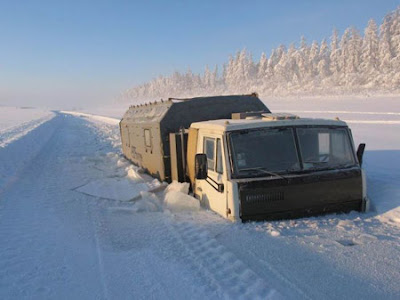IN the coldest village on Earth, eyelashes freeze, dinner is frozen and temperatures sink to -88F

IN this remote outpost in Siberia, the cold is no small affair.Eyelashes freeze, frostbite is a constant danger and cars are usually kept running even when not being used, lest their batteries die in temperatures that average minus-58 degrees Fahrenheit in the winter, according to news reports.This is Oymyakon, a settlement of some 500 people in Russia’s Yakutia region, that has earned the reputation as the coldest permanently occupied human settlement in the world.It is not a reputation that has been won easily. Earlier this week, a cold snap sent temperatures plunging toward record lows, with reports as extreme as minus-88 degrees Fahrenheit.The village recorded an all-time low of minus-98 degrees in 2013.Though schools in the area remain open as temperatures dip into the minus-40s, they were closed on Tuesday, the Associated Press reported.Dark 21 hours a day in the winter, the town has been an object of international curiosity as its reputation for fearsome cold and the resilient residents who withstand it year after year, has grown.Amos Chapple, a photojournalist from New Zealand, traveled to the region in 2015 to capture the subzero way of life. The village is remote, located closer to the Arctic Circle than to the nearest major city, some 500 miles away, and Chapple described an arduous trip to get there to The Washington Post. After a seven-hour flight from Moscow, some 3,300 miles away, he took a van to a nearby gas station and then hitched a ride to the village after two days waiting in a shack and living off reindeer soup.
“After the first couple of days I was physically wrecked just from strolling around the streets for a few hours,” he said.The harsh cold climate permeates nearly every aspect of existence for the people who live in the area.
The winter diet is mostly meat-based, sometimes eaten raw or frozen, due to the inability to grow crops in the frigid temperatures. Some regional specialties include stroganina, which is raw, long-sliced frozen fish; reindeer meat; raw, frozen horse liver, and ice cubes of horse blood with macaroni,
Video taken during the cold snap showed a market, open for business on the snowy tundra, frozen fish standing rigidly upright in buckets and boxes, no refrigeration needed.
Customers in heavy winter clothing walked by, one with a child in tow. The narrator said it was minus-56 degrees.
“Here is the treasure,” the video’s narrator said of the whitefish used to make stroganina. He admitted he was getting a bit cold shooting the video.
“While filming the trading rows my hands froze to wild pain. And sellers stand here all day long. How do they warm themselves?” he said, according to the Siberian Times.
The village was once a stopover in the 1920s and ’30s for reindeer herders who would water their flocks at a thermal spring that didn’t freeze. Bathrooms are mostly outhouses; the ground is too frozen for pipes. According to the Weather Channel, the ground has to be warmed with a bonfire to break into, such as for digging a grave.










0 comments :